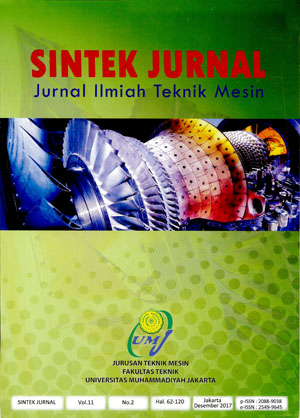PENGARUH WAKTU PERENDAMAN DAN PENAMBAHAN KONSENTRASI NaCl (PPM) TERHADAP LAJU KOROSI BAJA LATERIT
Main Article Content
Abstract
Article Details
- Articles published in SINTEK JURNAL are licensed under a Creative Commons Attribution-ShareAlike 4.0 International license. You are free to copy, transform, or redistribute articles for any lawful purpose in any medium, provided you give appropriate credit to the original author(s) and SINTEK JURNAL, link to the license, indicate if changes were made, and redistribute any derivative work under the same license.
- Copyright on articles is retained by the respective author(s), without restrictions. A non-exclusive license is granted to SINTEK JURNAL to publish the article and identify itself as its original publisher, along with the commercial right to include the article in a hardcopy issue for sale to libraries and individuals.
- By publishing in SINTEK JURNAL, authors grant any third party the right to use their article to the extent provided by the Creative Commons Attribution-ShareAlike 4.0 International license.
References
Purwanto, Hadi, dkk. 2003. “Recovery Nickel from Selectively Reduced Laterite Ore by Sulphuric Acid Leaching”. ISIJ International Journal, Vol.43, No.2, Hal. 181-186
ASM Handbook Vol. 13A. 2003. Corrosion: Fundamentals, Testing, and Protection. American Society of Material Press
ASM Speciality Handbook. 1996. Carbon and Alloy Steel. American Society of Material Press
Febriyanti, Eka. 2009.”Laju Korosi Baja Laterite dan Baja Hematite terhadap Penambahan Konsentrasi NaCl (ppm)”. Majalah Ilmiah : Material, Komponen, dan Konstruksi. Vol. 9. No.2. Hal.94-103
ASTM E3-01. 2012. Standard Guide for Preparation for Metallographic Specimens. American Standard for Testing Materials Press
Dhanapal A., dkk. 2012. “Influence of pH Value, Chloride Ion Concentration, and Immersion Time on Corrosion Rate of Friction Stir Welded AZ61A Magnesium Alloy Weldments”. Journal of Alloys and Compound. Vol. 523. Hal 49-60
Qi, Yameng, dkk. 2013. “Effect of Immersion Time on The Hydrogen Content and Tensile Properties of A350LF2 Steel Exposed to Hydrogen Sulphide Environments”. Corrosion Science. Vol. 69. Al. 169-174
Wang, Lei, dkk. 2010. “Corrosion Behaviour of AZ91 Magnesium Alloy in Dilute NaCl Solutions”. Materials and Design. Vol. 31. Hal. 857-863
Osaralube, dkk. 2008. ”Corrosion Behaviour of Mild and High Steel in Various Acidic Media”. Scientific Research and Essay Academic Journals. Hal. 224
Liu, J., dkk. 2005. “Study of Cavitation Corrosion Behaviours and Mechanism of Carbon Steel in Neutral Sodium Chloride Aqueous Solution”. Proquest Science Journal. Vol. 61. Issue 11. Hal. 1061-1070
Song, G. dan A.Atrens. 2003. “Understanding Magnesium Corrosion : Framework for Improved Alloy Performance”. Advanced Engineerin Materials. Vol. 50. Issue 12. Hal. 837-858
Y.S., Choi, dan Kim JG. 2000. “Aqueous Corrosion Behaviour of Weathering Steel and Carbon Steel in Acid Chloride Environment”. Proquest Science Journal. Hal.1202
Garci’a, K.E., dkk. 2005. “New Contributions to The Understanding of A Rust Layer Formation in Steels Exposed to A Total Immersion Test”. Elsevier Ltd.
Cheng, Y.F. 2004. “ Corrosion of Carbon Steels in High-Temperature Water Studied by Electrochemical Techniques”. Elsevier
Y.S., Choi, dkk. 2005. “Effects of Chronium, Cobalt, Copper, Nickel, and Calcium on The Corrosion Behaviour of Low Carbon Steel in Synthetic Ground Water”. Proquest Science Journals. Hal. 490
.


